PC Club Enpower ENP660: Back to School
by Jarred Walton on August 14, 2007 7:00 AM EST- Posted in
- Laptops
LCD Brightness, Contrast, and Viewing Angles
In keeping with our tradition of striving to provide the most detailed hardware reviews around, we took a closer look at the LCD used in the ENP660. As usual, we cannot guarantee that the LCD panel used in our particular sample will be the same as that used in other notebooks, even if they have the same model number. However, as we will see in just a moment it is unlikely that other ENP660/MS-1637 notebooks could have a display that's any worse than the model we're testing. That's not to say that the display is absolutely terrible, but it definitely leaves room for improvement.
Using ASTRA32, a utility to that probes for various low-level details about computer hardware, the LCD panel in our test unit is listed as an AU Optronics B154EW01 V9. It is entirely possible for ASTRA32 to make mistakes, but short of tearing apart the notebooks we review - and potentially ruining the LCD panels - that's the best information we can provide. The manufacturing date is listed as January 2005, and it goes without saying that LCDs have improved quite a bit in the past 30 months. Our general impressions of the LCD panel are what you would expect: okay horizontal viewing angles, poor vertical viewing angles, and relatively poor color reproduction. The display seems to be bright enough, but the overall appearance is washed out. While it's by no means a good LCD, the display will work fine for most business and personal use; graphics artists and other image professionals will want better however.
For our objective tests, we'll start with a look at brightness and contrast ratios along with viewing angles. We'll conclude on the following page with an examination of the color accuracy, before and after hardware calibration. For color accuracy, we are including results using ColorEyes Display Pro in addition to Monaco Optix XR Pro. Monaco Optix XR Pro uses the older ICCv2 profile specification and it may not be as accurate as software that uses the more recent ICCv4 specification. In testing we have discovered that there are certainly differences between the two software packages when it comes to color calibration, but neither one is universally better. We use a Monaco Optix XR Pro colorimeter (which is the same as the DTP-94) with both software packages.
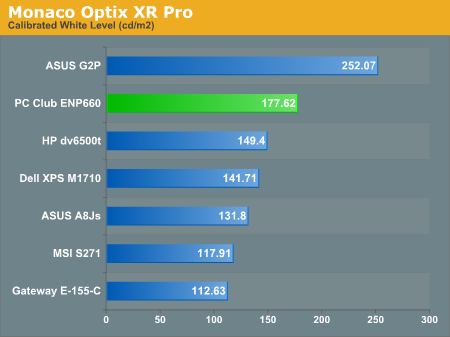
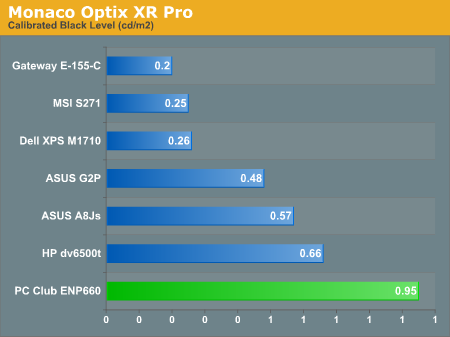
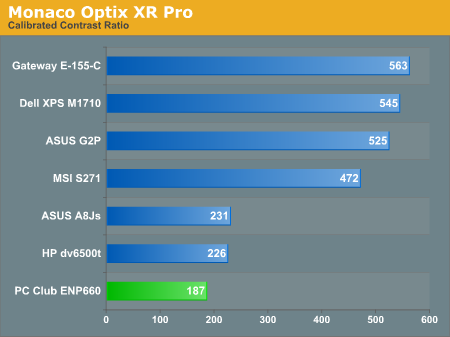
The white level is pretty good, coming in slightly higher than most other laptops that are around 150 nits. Black levels on the other hand are nowhere near black. The end result is a low contrast ratio that gives the display a washed out appearance.
Brightness levels and contrast ratios aren't the only important aspects of a display, so let's look at the viewing angles, taken at 30° from center. Images for the other laptops can be viewed at the following links:
ASUS A8Js
ASUS G2P
Dell M1710
HP dv6500t
Gateway E-155-C
MSI S271
This is one of the worse showings in terms of viewing angles of the laptops that we've reviewed - not too surprising considering the age of the LCD panel. The limited vertical viewing angle is definitely noticeable when using the laptop, especially if it's actually sitting in your lap. A slight shift or repositioning of your body and the image on the LCD can become seriously discolored. If you like clear, vibrant displays then you will definitely want to look around for a better notebook.
Looking at response times for such a notebook is almost meaningless, particularly as it relates to gaming. As the above image shows, even on relatively tame graphics the GMA X3100 has difficulty reaching high frame rates. Even at a low 640x400 resolution, we couldn't break 60 frames per second which means that we almost certainly captured one frame rendered twice. In other testing, response times appeared to be similar to what we've seen on most notebooks - somewhere between 25ms and 35ms. Watching movies worked well enough: assuming you can get past the viewing angles and low contrast ratio, response time is in going to be a problem.
In keeping with our tradition of striving to provide the most detailed hardware reviews around, we took a closer look at the LCD used in the ENP660. As usual, we cannot guarantee that the LCD panel used in our particular sample will be the same as that used in other notebooks, even if they have the same model number. However, as we will see in just a moment it is unlikely that other ENP660/MS-1637 notebooks could have a display that's any worse than the model we're testing. That's not to say that the display is absolutely terrible, but it definitely leaves room for improvement.
Using ASTRA32, a utility to that probes for various low-level details about computer hardware, the LCD panel in our test unit is listed as an AU Optronics B154EW01 V9. It is entirely possible for ASTRA32 to make mistakes, but short of tearing apart the notebooks we review - and potentially ruining the LCD panels - that's the best information we can provide. The manufacturing date is listed as January 2005, and it goes without saying that LCDs have improved quite a bit in the past 30 months. Our general impressions of the LCD panel are what you would expect: okay horizontal viewing angles, poor vertical viewing angles, and relatively poor color reproduction. The display seems to be bright enough, but the overall appearance is washed out. While it's by no means a good LCD, the display will work fine for most business and personal use; graphics artists and other image professionals will want better however.
For our objective tests, we'll start with a look at brightness and contrast ratios along with viewing angles. We'll conclude on the following page with an examination of the color accuracy, before and after hardware calibration. For color accuracy, we are including results using ColorEyes Display Pro in addition to Monaco Optix XR Pro. Monaco Optix XR Pro uses the older ICCv2 profile specification and it may not be as accurate as software that uses the more recent ICCv4 specification. In testing we have discovered that there are certainly differences between the two software packages when it comes to color calibration, but neither one is universally better. We use a Monaco Optix XR Pro colorimeter (which is the same as the DTP-94) with both software packages.



The white level is pretty good, coming in slightly higher than most other laptops that are around 150 nits. Black levels on the other hand are nowhere near black. The end result is a low contrast ratio that gives the display a washed out appearance.
Brightness levels and contrast ratios aren't the only important aspects of a display, so let's look at the viewing angles, taken at 30° from center. Images for the other laptops can be viewed at the following links:
ASUS A8Js
ASUS G2P
Dell M1710
HP dv6500t
Gateway E-155-C
MSI S271
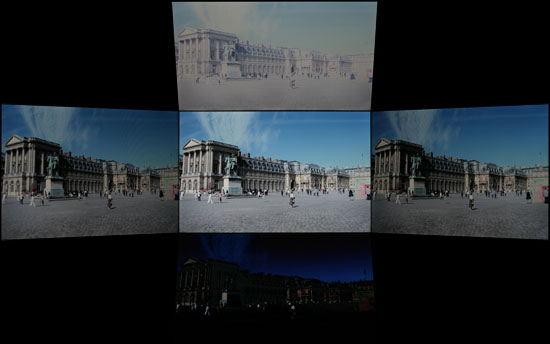 |
This is one of the worse showings in terms of viewing angles of the laptops that we've reviewed - not too surprising considering the age of the LCD panel. The limited vertical viewing angle is definitely noticeable when using the laptop, especially if it's actually sitting in your lap. A slight shift or repositioning of your body and the image on the LCD can become seriously discolored. If you like clear, vibrant displays then you will definitely want to look around for a better notebook.
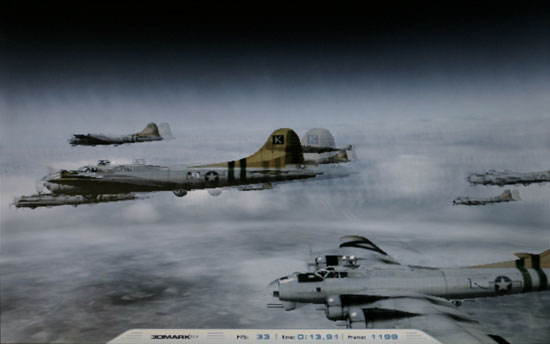 |
Looking at response times for such a notebook is almost meaningless, particularly as it relates to gaming. As the above image shows, even on relatively tame graphics the GMA X3100 has difficulty reaching high frame rates. Even at a low 640x400 resolution, we couldn't break 60 frames per second which means that we almost certainly captured one frame rendered twice. In other testing, response times appeared to be similar to what we've seen on most notebooks - somewhere between 25ms and 35ms. Watching movies worked well enough: assuming you can get past the viewing angles and low contrast ratio, response time is in going to be a problem.










11 Comments
View All Comments
Pol Newman - Wednesday, October 21, 2020 - link
You need an expensive laptop to study well